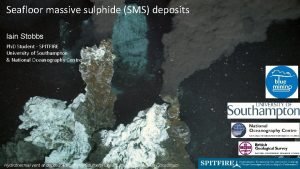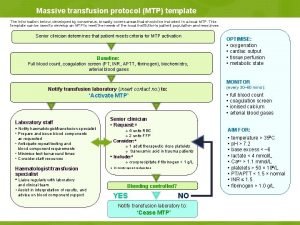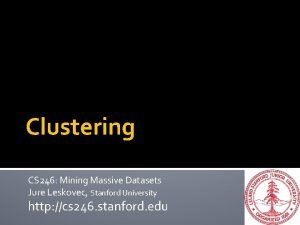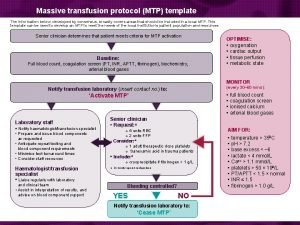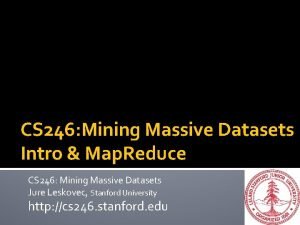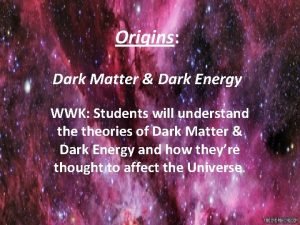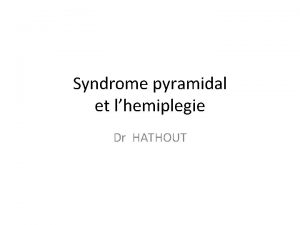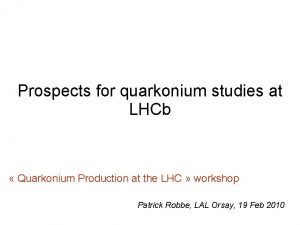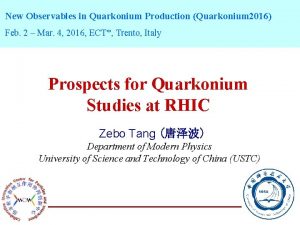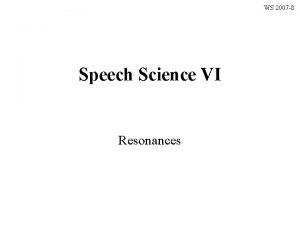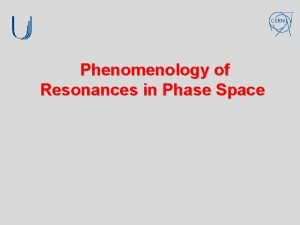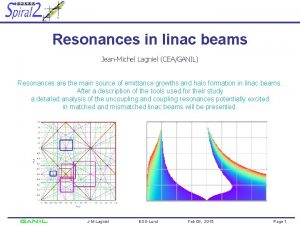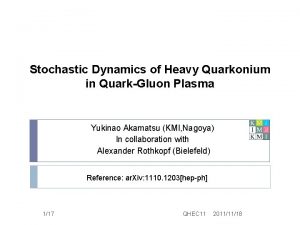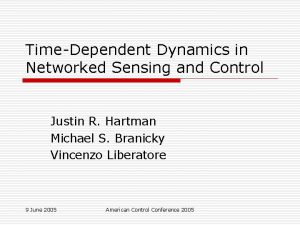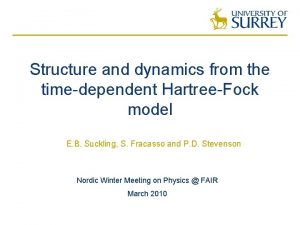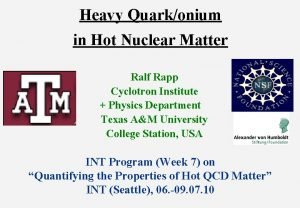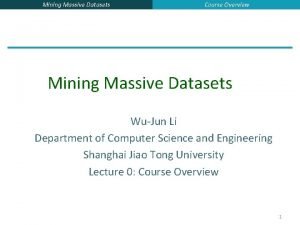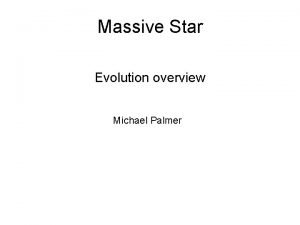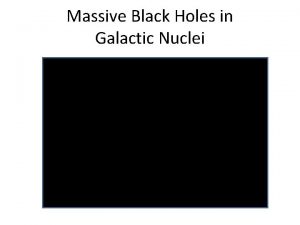TIMEDEPENDENT DYNAMICS OF MASSIVE QUARKONIUM RESONANCES IN NUCLEAR






















- Slides: 22

TIME-DEPENDENT DYNAMICS OF MASSIVE QUARKONIUM RESONANCES IN NUCLEAR AND QUARK-GLUON-PLASMA MEDIA NOOR SABRINA MAH HUSSIN, Drake University ASMAA SHALABY, Benha University ATHANASIOS PETRIDIS, Drake University

J/ψ Propagation and decay in QGP • The time-dependent in-medium propagation of quark-antiquark pairs coupled via the strong interaction can be studied with the appropriate initial conditions describing a meson (e. g. , J/Ψ). • The problem can be approached nonrelativistically obtaining the initial wave function via the Schrödinger equation using imaginary time.

J/Psi (charmonium) • Ground state of a charm-anticharm quark pair bound by a confining strong-interaction potetial (Mass = 3 Ge. V, Spin = 1). • It appears as resonance in collisions decaying mostly into other hadrons. Slope = α β x Confining potential with asymptotic freedom at small r.

Quark-Gluon-Plasma • A large system of quarks and gluons at high temperature that are asymptotically free in an extended region. • Discovered in 2001 (Brookhaven National Lab), in heavy ion collisions, it was also the state of the universe right after the Big Bang. • In QGP the J/ψ is expected to dissolve (suppressed production) due to extended asymptotic freedom (temperatures of the order of the charm-quark mass. This suppression is a signature of the QGP.

The approach followed • Use the time-dependent Schrödinger equation with an external, quasi-binding potential and an initial wave function describing the J/ψ to calculate its propagation in QGP (extended asymptotic freedom) or nuclear medium (periodic in space/time). • The initial wave function will be obtained with the time-dependent Schrödinger equation using imaginary time propagation and the binding potential in which the J/ψ is the ground state.

Time-dependent Schrödinger equation The potential may also depend on time for a nuclear medium or an expanding QGP.

Staggered-Leap-Frog Method • Numerical solution to the equation on a spatial grid (∆x), with time step (∆t): Reflecting Boundary Conditions used. We have also developed Totally Absorbing Boundary Conditions.

Von Neuman stability- real time • Stable plane-wave solution (discrete): • V=0:

Stability – real time (cont. ) |R| is required to be 1 for stability which means If then it is always satisfied for the free equation and for the coupled equation if is sufficiently small compared to Vmax.

Imaginary time propagation Renormalization is done after each time step.

Stability-imaginary time (cont. ) In this case |R| is always < 1. This guarantees stability (convergence to the ground state). Larger time-steps can be used.

Imaginary time: HO potential (test) • • The ground state for the Harmonic Oscillator potential is accurately produced. Excited states can also be produced after projecting out the ground state (and lower excited states).

Imaginary time: confining potential • Ground state, y 0(x) , in 1 dimension. Here the string tension α = 0. 23 and β = 0. 5.

Real-time propagation • The asymptotic range is adiabatically increased to the size of QGP: β becomes larger with α kept fixed. • The initial J/ψ wavefunction, y 0(x) (produced in a pre. QGP hard collision of quarks and gluons), propagates in the extended potential with central p > 0. • Initial wave function for real-time propagation with possible central momentum, p:

Probability density versus time: cut linear potential p=0 β p=1 Here x* = 2 β with β = 4 There is partial reflection and partial tunneling. x* x

Probability density versus time: leveled linear potential β Here x* = 2 β with β = 4. The “exterior” vacuum is higher than the interior one. There is partial reflection and partial tunneling. x* x

Survival probability versus time p=0 The difference between the results for the two potentials is small. The p ≠ 0 cases decay faster. p=1 Non-exponential decay exhibiting oscillations. This decay is exactly resonant because the potential is changed.

Non-exponential decay • Resonance decay (simplistic expectation for J/ψ, alpha emission etc). • Breit-Wigner energy distribution (dual poles): • Energy convolution over eigenfunctions

Corrections to resonant decay • The major contribution happens at E 0 : Exponential plus power-law terms with oscillations.

Non-resonant decay • Infinite wall plus delta-function potential: • Exponential energy function: • Survival probability:

Comparison with exponential decay • The difference is pronounced at small and large t (left). The “extended” (0 to L’ > L) probability undulates (right).

Future developments • More realistic potential models for both the initial ground state and the QGP. • Include possible formation of the quarkonium inside the QGP. • Include expansion of the QGP with time. • For a nuclear medium use a potential that is periodic in time in the reference frame of the quarkonium. This represents the relative motion and collisions with nucleons.
 Fisión nuclear vs fision nuclear
Fisión nuclear vs fision nuclear Lesson 15 nuclear quest nuclear reactions
Lesson 15 nuclear quest nuclear reactions Massive transfusion complication
Massive transfusion complication Seabed massive sulphides (sms)
Seabed massive sulphides (sms) Massive io
Massive io Massive wood chipper
Massive wood chipper Massive transfusion protocol template
Massive transfusion protocol template Mining massive datasets
Mining massive datasets Massive open online courses
Massive open online courses Mining of massive datasets solution
Mining of massive datasets solution A scalable bootstrap for massive data
A scalable bootstrap for massive data Massive transformative purpose examples
Massive transformative purpose examples Middleton maneuver spleen
Middleton maneuver spleen What is the life cycle of a medium mass star
What is the life cycle of a medium mass star Nagma vs hagma
Nagma vs hagma Chapter 15 furniture styles and construction answer key
Chapter 15 furniture styles and construction answer key Endophytes are primary producers that live
Endophytes are primary producers that live Mtp template
Mtp template There.once.was.a.woman
There.once.was.a.woman Cs246 stanford
Cs246 stanford Massive compact halo objects
Massive compact halo objects Complications of blood transfusion
Complications of blood transfusion Hémiplégie massive proportionnelle
Hémiplégie massive proportionnelle



